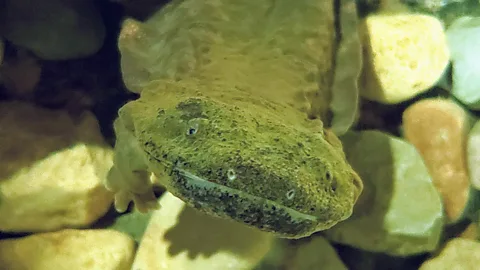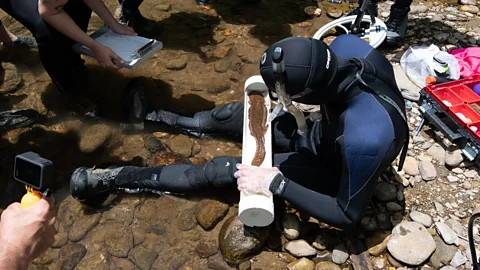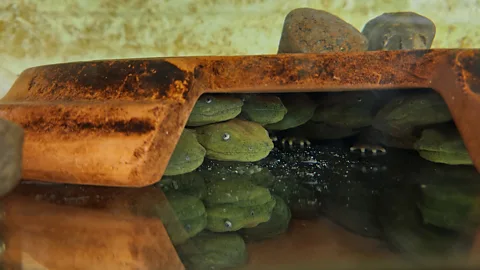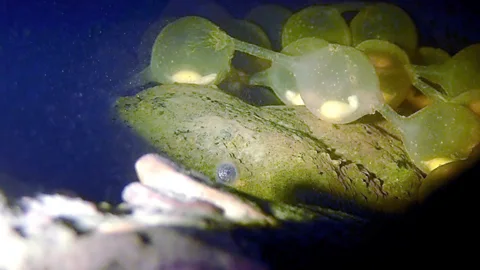Meet the snot otter, the US's ancient and unique salamander
 Purdue University
Purdue UniversityScuba diving scientists are scouring riverbeds for the elusive, endangered hellbender – also known as the snot otter, or lasagne lizard – to give them a fighting chance of survival.
The dark, rushing, bracingly cold waters of North Carolina's Watauga River don't make life easy for the conservationists trying to locate rare and endangered Eastern hellbenders.
Earlier this summer, a team of scientists decked out in scuba gear and scoured the riverbed up to 18ft (5.5m) below the surface. Working mainly in the hours around midnight, their work required powerful dive lights and a little animal psychology.
"Hellbenders are difficult to find," says Andy Hill of the conservation organisation MountainTrue, where he is High Country regional director and Watauga riverkeeper, the key protector, watchdog and spokesperson for the Watauga River watershed. "They're perfectly camouflaged. We try to get into the mind of a hellbender – we identify quality habitat and look for clear, cold-running water. We look under every rock and crevice. You train your eye to look for movement – a blinking eye, a flash. You're elated every time you find one."
Every hellbender counts in the mission to save the largest aquatic salamander species in North America. The elusive, little-known freshwater amphibians, which can grow up to 29in (74cm) long, live in rivers in underwater caves or dens formed by boulders. They have broad, flat heads and stocky, flattened bodies that help them blend into rocky stream beds, with short strong limbs and small beady eyes on top of their heads. They're usually grey or brown in colour, with blotchy or mottled skin that helps them to remain camouflaged in rocky riverbeds.
The animal also goes by the nicknames "snot otter" (due to their slimy skin, which secretes mucus to protect them against bacteria and parasites), "devil dog", "grampus". Their skin is wrinkled and loose, especially along the sides of their bodies, which increases the surface area for respiration, as hellbenders can absorb oxygen through their skin – those flappy folds of skin along their torsos look like a cooked lasagne, earning them another nickname: "lasagne lizard". The salamanders are hard to spot, not just because they're good at hiding, but because their numbers are dwindling.
An unloved amphibian
Sometimes wrongly thought to be venomous or capable of administering electric shocks, the hellbender has at times gained a poor reputation. This large salamander is in fact a harmless creature. Nor does the hellbender compete significantly with anglers for game fish such as trout. Instead, they prefer to eat small fish such as crayfish.
Previously widespread across 15 US states, from southern New York to northern Georgia and from the central Appalachians to Missouri, nearly 80% of hellbenders have been wiped out across their range. Hellbenders are listed as near-threatened by the International Union for Conservation of Nature (IUCN). In some areas, particularly in the Ozarks and the Appalachian regions, they are currently endangered or have gone locally extinct. In North Carolina, hellbenders are a "species of special concern" (a legal designation for wildlife facing significant risks).
 Karim Olaechea/MountainTrue
Karim Olaechea/MountainTrueHill's latest surveys for the hellbender in the Watauga River ran for five days in June. Working as part of a crew of 10 scuba-diving scientists from MountainTrue, North Carolina Wildlife Resources Commission, American Rivers and Appalachian State University, the team's task was to find hellbenders and move them out of harm's way, ahead of removing a dam on the river. Shull's Mill Dam is an old gristmill that dates back to the 19th Century, previously used to grind farmers' grain.
In total, the team removed nine hellbenders: four adult females, four adult males and one immature (larval stage) hellbender. The hellbenders were placed in temporary wooden and soft meshed enclosures, which were then anchored to the riverbed in a new site 14 miles (23km) downstream, a high-quality habitat created by the removal of another dam, Ward's Mill, in 2021. They remained in enclosures for 48 hours before release, to recover from the stress of relocation and acclimatise to their new surroundings. This helps survival rates, according to Hill. The hellbenders have been tagged and will now be monitored to see if they stay and breed in the new location, or move elsewhere.
It's not the first time hellbenders have been relocated in the US for works such as bridge replacements or road projects. But this was the first time hellbenders were moved from one dam-removal site to a spot where a dam had already been removed, says Hill. Rescuing as many adult hellbenders as possible is important, explains Hill, as long-living breeding adults contribute many generations to the population. (Read more about the US's largest dam removals.)
The dam problem
Declines in hellbender numbers have been caused by habitat loss, water pollution, land-use changes and other issues, including climate change – severe rain and flooding introduce more sediment and pollution into rivers. Dams are also an issue. Hellbenders don't travel much as adults – they occasionally make journeys for breeding, but usually they establish a territory within a small area. Juveniles, though, will disperse over longer distances. Dams can block breeding journeys and dispersal, which impacts gene flow. Dams can also degrade the quality of upstream habitat.
 Purdue University
Purdue UniversityHellbenders are far from the only species facing these problems. The 78-mile (126km) Watauga River, which begins near Boone in western North Carolina, an area known as the High Country, and flows out to eastern Tennessee, is home to numerous aquatic species that are now threatened by human-caused problems. Dam removals are an increasingly valued strategy to restore river ecosystems in the United States, Europe and around the world, improving water quality and sediment flow to restore ecosystems, to the benefit of people, businesses (outdoor recreation, tourism) and a range of wildlife.
With dam removals and river conservation, fish – such as trout and salmon – are often the focus, Hill points out. But amphibians and many other species live in and around rivers too. "When a dam is removed, the entire ecosystem benefits," he says.
Nearly 41% of amphibian species around the world, including salamanders, frogs, newts and toads, are currently at risk of extinction, making the group the most threatened class of vertebrates. Habitat loss affects 93% of those threatened amphibians.
"There is no recorded decline as drastic as the one experienced by amphibians," says Amaël Borzée, co-chair of the amphibian specialist group at the IUCN's Species Survival Commission. "Declines are not localised – they're truly global. The main threat is habitat loss and degradation – preventing further habitat degradation would be vital."
Climate change is also proving to be more of a risk than previously thought, says Borzéem, as are the impacts of extractive industries such as mining. "While most species can face threats once at a time, the synergy of threats touching amphibians is deadly to numerous species."
In July, the amphibian specialist group called for urgent global action to prevent further losses. Like insects or unpopular species like vultures, amphibians "only extremely rarely get the attention they need", says Borzée. "There are very few protected areas focusing on an amphibian population, despite the number of threatened species. Amphibians have permeable skin and often live in both aquatic and terrestrial habitats, so they can be incredibly sensitive to environmental changes, such as pollution."
 Zach Truelock/ Purdue University
Zach Truelock/ Purdue UniversityIn the United States, there have been successful captive-breeding programmes for hellbenders, which have then been released into the wild. This year, 338 juvenile Eastern hellbenders raised from eggs at Indianapolis Zoo are being released in southern Indiana, bringing the total to 852 since releases began in 2017. The project has 13 release sites in a 50km (31-mile) stretch of Indiana's Blue River, with experimental releases now being trialled on a second river.
"In the past Hellbenders could be found in high numbers and were likely one of the top predators, so we can imagine the impacts on the food web of removing a high-level predator from a system," says Nick Burgmeier, Help the Hellbender's project coordinator at Purdue University, who collected the original eggs for the project from a stream in eastern Kentucky.
"They're also an excellent indicator of water quality – when they disappear, it's a sign of a reduced water quality," says Burgmeier. "Aside from their ecological role, they're an ancient, truly unique species. It's one of those creatures that when it's gone, it's gone – there is no realistic turning back from extinction."
One factor the hellbender has in its favour – once you get past its odd looks – is a certain charm.
"Almost everyone I've met finds them fascinating," Burgmeier says. "But they were once feared because people thought they were harmfully poisonous or that they ate all of the 'good' fish. Neither of these things is true – they mostly just sit around waiting for crayfish or small fish to wander by."
Protecting the hellbender is just one part of a much broader task to save amphibians as a group, including those sometimes seen as lacking in conventional charisma. "As humans have damaged ecosystems and caused global climate change, it is our duty to protect the species we are rushing towards extinction," says Borzée. "We don't have the right to let these fascinating species go extinct under our watch."
--
For essential climate news and hopeful developments to your inbox, sign up to the Future Earth newsletter, while The Essential List delivers a handpicked selection of features and insights twice a week.
